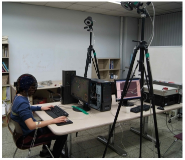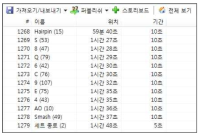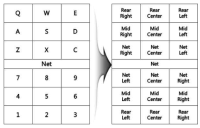
The purpose of this study was to determine how acute active pc-video game affects kinematic variables and muscle activities of adolescents. Fourteen middle school students(age: 15.9±0.7 yrs, height: 171.3±6.1cm, weight: 60.0±5.4 kg, right handed) who have no musculoskeletal disorder were recruited as the subject according to having experience in using the pc-video game for more than six months. Maximum angle, angular velocity, and muscle activity of the upper extremity were determined for each trial. For each dependent variable, a paired t-test was performed to test if significant difference existed between pre- and post a 60 minute active pc-video game(p<.05). This study found that one hour pc-video game hour may not affect on movement and ROM of the finger and the wrist, whereas it may have an effect on muscle activity of the upper extremity. It seems that repetitive movement pattern during an active pc-video game may hinder muscle activity of adolescents’ upper extremity. Part of the increase in musculoskeletal disorders is linked to the amount of time adolescents are allowed to play video games. This study found that an active pc-video game appears to have negative effects on the upper extremity muscles. Since wrist movements are continually repeated throughout the video game, carpal tunnel syndrome may possibly be caused by long-term exposure to video games.


The purpose of this study was to analyze the differences among behavioral skills of goalkeeper of K-League and national team and the differences among behavioral skills of goalkeeper according to game the result of match. 5 games of K-League Classic and 10 A matches of the national team in 2013 were analyzed by using Soccer Data Analysis Program and ‘Evermedia HD Capture Station’, which is an HD capture equipment with excellent functions of editing and storage of high-definition video. For statistical analysis process, SPSS Version 21.0 was used to conduct t-test and ANOVA. The results of analysis were as follows: First, the differences among behavioral skills of goalkeeper of K-League and national team were higher in the order of catching factor, kick factor, strategy factor, punching factor. The differences among the specific sub-factors of behavioral skills factors was the highest in crossing catching to be followed by cross punching. And goalkeepers of K-League were higher than those of the national team. In back pass kick factor in kick factor and build-up factor in strategy factor, goalkeepers of the national team were higher than those of K-League. In kick factor, there were significant differences in goal kick (out of play), back pass kick (in play), cross punching, and build-up factors. Second, as for behavioral skills factors of goalkeeper according to the result of match, there were significant differences in catching factor, punching factor, and strategy factor; there were no significant differences in ground kick factor among kick factors; there were significant differences in factors of goal kick, volley kick, and free kick.
The purpose of this study was to investigate the level of factors associated with points and the difference among weight categories after the revision of wrestling competition rules from video images. Factors associated with points were average point per a game, average points according to playing type, the occurring frequency of point according to the skills, the frequency and successful ratio of Parter, and the time zone of points occurred. The video contents were concerned on athletes ranked in 1 - 5 (6 person) at 59, 66, 75 Kg categories of Greco-Roman style in the 2014, 2015 World Wrestling Championship. The analysis was done by watching TV monitor several times. Five quantitative factors were tested between weight categories. As the results, no significant difference was found in average obtained point, but significant difference was found in average lost point (p<.05). Average obtained point showed significant difference in cross effect of the type of game and weight category. And average lost point showed significant difference in the type of game (p<.01) and weight category (p<.05), too. The frequency of point by skills of stand and ground wrestling showed significant difference in weight category (p<.001). However, no significant difference was found in frequency of point by time zone among weight categories. In conclusion, the point obtained and lost and the frequency of it are associated with the type of game and skills included in it of Greco-Roman style wrestling. New training program focused on enforcing the correct type of game and skills in it might be useful for developing the performance.
PURPOSE This study aimed to compare and analyze the game content of the “3-rounds, 2-win system” matches before and after the rule revision implemented in 2022. METHODS This study covered 72 matches from the 2019 Rome World Championships Grand Prix, 92 matches from the Sofia World Championship Grand Prix, and 173 matches from the 2022 Rome World Championships Grand Prix. In total, 337 game videos were analyzed to assess the players‘ game content before and after the rule revision. RESULTS Analyzing the basic skills before and after the revision shows that the frequency of round kicks and pushes was high. Notably, while the frequency of round kicks, which are primarily used by players, decreased after the revision, the scoring success rate increased. CONCLUSIONS Based on the research findings, it is believed that post-revision, players are focusing more on game management aimed at scoring rather than attempting preliminary movements or connecting kicks to deceive their opponents.
PURPOSE This study examined whether K-league fans’ responses to game outcomes align with reference-dependent preference and loss aversion principles. METHODS We collected user comments from the 2023 K-league game highlights videos on YouTube. We identified each user’s supporting team and excluded neutral fans’ comments. Sentiment analysis using KoBERT was applied, and estimated sentiment scores served as dependent variables. We performed panel regression to test whether unexpected wins and losses generate positive and negative comments. RESULTS First, an unexpected win generates more positive comments, and an unexpected loss generates more negative comments; a reference-dependent preference exists. Second, the difference between the coefficient on upset win and the absolute value of the coefficient on upset loss is not statistically different; loss aversion does not exist. CONCLUSIONS The findings derive a deeper understanding of sports viewership and explain the difference between domestic and overseas sports fans. Also, the findings provide insights into the domestic professional sports business.

This study aimed to analyze the patterns of service return and the 3rd stroke in relation to the winning and losing points in Badminton men's doubles matches. Especially the comparison of the patterns between rally point and service server game systems was made. Video records of 12 top elite teams were analyzed. As a result, there were significant differences in the total stroke patterns between the rally point system and the server game, and there was a higher offensive stroke tendency. After classification of situations with ‘after the service trial’ and ‘after the service return’, there were high number of winning ratio and offensive stroke in the after the service situations. There were no significant difference in the winning/losing points and winning ratio when the types of 3rd shot attempts were analyzed. I case of the win and lose in service return, there was a significant difference in the server game while not in the rally point system. Offensive stroke ratio in the server’s return categories and the service return strokes’ categories, and was no difference in shots after the return of service in the server team. From the investigation of offensive stroke ratio and winning ratio, there was a high ratio in the rally point system game but no difference in the server game. When aggressive service return took place, rally point system had higher winning ratio, but the server game system did not display such characteristic. Based on these results, recommendations of service anticipation and aggressive plays for Korean Men's doubles game have been suggested.


This study aims to visualize the data regarding the entire rally and the final 5 strokes in a badminton single match and to present its analysis method using the parallel coordinate system. For this study, were used the videos of three games of the final, semifinal, quarterfinal in the '2014 National Fall Badminton Championship’ where the L Player of Gyeonggi C university won championship. Herein, the data was collected utilizing a tagging technique of Dartfish (Ver 8.0), in terms of shuttlecock ball direction, judgment of final kill stroke, and used technique. The data collected were classified and condensed using Excel 2013 program, and the parallel coordinates, which is provided with free open source through D3js.org, was utilized as a data visualization tool. As the results; first, the entire rally of single matches in badminton was visualized; second, as an analysis method of data visualization in relation to final 5 strokes, game pattern analysis, attack success course analysis by players and techniques, attack failure course analysis by players and techniques, and a plurality of selected condition analysis by players and techniques could be presented. In future, when processing subsequent studies that can provide us together with numerically analyzed data as well as visualization through a parallel coordinate system, it is expected that this study could be applicable to a variety of events and utilized in the actual sports games.











The present study has been carried out with a purpose of a long term estimation for the body size and BMI (Body Mass Index) of Korean children and youth using ARIMA, a time series model. In order to select an estimation model for the optimum time series, among the time series analysis method of SPSS22.0 statistic programs, a multivariate ARIMA (p,d,q) model has been selected that has an input series (physical education facility, time spent for physical education, animal source foods, GDP deflator, animal source food intake ratio), using annual average data of height, weight, and BMI data from 1965 to 2015. Among the several optimal measurements in ARIMA model with estimation variables, an optimal RMSE-based model (RMSE: Root Mean Square Error) has been selected. Using this model, the estimation model and estimated values of children’s height, weight, and BMI have been suggested for each age group. The results are as the following. The trend estimation of height follows a logistic curve, with both male and female groups showing increasing trends. The weight has a trend of increasing ratio higher than height. BMI also shows a trend curve similar to weight. The estimation model has been mostly ARIMA(0,1,0). In particular, the average BMI has been estimated as 22-23 for male students in 6th, 8th, 9th, 11th and 12th grade in 2030. This indicates the recent increasing obesity as children and youth occupy most of daily time for play culture that is far from physical activities, such as computer games, smartphone games, and video games at home.






PURPOSE Neuromarketing measures and analyzes the unconscious response of consumer brain waves to marketing stimuli in real time. This study examined how a sensational scene (accident) in a sport game influences the sponsorship effects through electroencephalography (EEG) analysis. METHODS The current study uses an experimental method. First, as an experimental stimulus, a video of F1 racing edited in a total of 9 min and 39 s was used, and an accident scene was inserted in the middle of the video. A total of 46 people participated in the experiment, and all participants watched the F1 video, including the accident scene. Participants' brain waves were observed in two prefrontal and two occipital lobes. The relationship between scene sensation and sponsorship effect was analyzed based on alpha waves and the sponsor brand recall measured by questionnaires. RESULTS First, the accident scene of the race caused the power of alpha wave to be abruptly reduced (i.e., alpha blocking). Second, the difference between the alpha power level of the group that recalled the sponsor brand and that of the group that did not recall was statistically insignificant; hence, the hypothesis was rejected. Third, the right-brain dominance (negative emotion) in the accident scene of the race was statistically insignificant; therefore, the hypothesis was rejected. Finally, the group that recalled the sponsor brand showed a left-brain dominance (positive emotion), which was statistically significant. CONCLUSIONS This study confirmed the marketing communication and neuromarketing theories on the sponsorship effects created by stimulation, attention, and memory in a sport sponsorship setting, observing alpha blocking phenomena in a sensational scene (accidents). In addition, it was revealed that the group that watched the same accident scene relatively positively and exited remembered the sponsor brand better than the group that did not watch it. The result implied that sport fan’s personal trait (e.g., sensation seeking) to sensation in sponsorship activities affects the sponsorship effect. The results also emphasized the importance of selecting target customers of sports fans in sponsorship to maximize sponsorship effects.
PURPOSE This study aimed to analyze the difference between scores and loss of world-class fencing sabre players. METHODS A total of 78 match videos and 1969 points of international competition over 3 years were analyzed for the nine major competitors of the national fencing team (Males = 5, Females = 4). The characteristics of each skill, body section and location according to the score were analyzed by dividing them into male and female groups. Data were analyzed using IBM SPSS ver. 25.0. RESULTS First, in the situation analysis according to the men's sabre score, attack skills were the most common in the winning situation (447 points, 73%) and in the situation of losing points (389 points, 72%); however, the difference was not significant. In the analysis of the piste location according to the score, B4 was the most common appearing 254 times (41.5%) in the scoring situation and A4, 243 (45%) times in the losing situation, with a significant difference (p < 0.001). Second, in the situation analysis according to the women’s sabre score, 315 attacks (70.6%) were found in the winning situation and 277 (74.7%) in the losing situation; however, the difference was not significant. In the analysis of the scoring body part, the Sixte area scored the highest with 121 points (27.1%), and the arm area lost the most points with 105 points (28.3%); however, the difference was not significant. In the analysis of the piste location according to the score, A4 was the most common in, appearing 179 times (40.1%) in the scoring situation, and 182 times (48.8%) in the losing situation, with no significant difference at the p < 0.001 level. CONCLUSIONS In the men's game, there were many scored points in B4 and many lost points in A4. In the women's game, there were many scored points and lost points in A4; therefore, the difference in goals and losses according to the piste position was confirmed. These results suggest that it is possible to infer the game management patterns of world sabre players and the flow of world fencing.